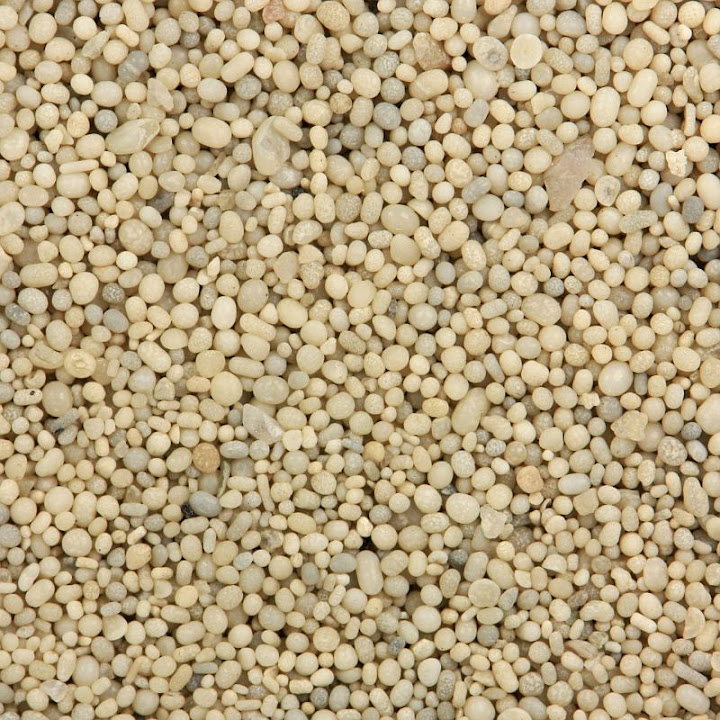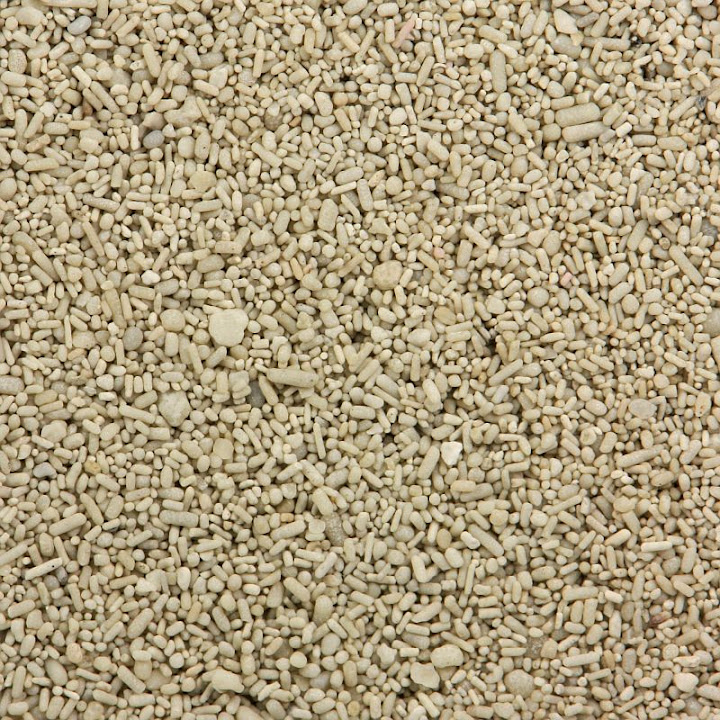Oolite is a sedimentary rock made up of ooids (ooliths) that are cemented together. Most oolites are limestones — ooids are made of calcium carbonate (minerals aragonite or calcite). Ooids are spheroidal grains with a nucleus and mineral cortex accreted around it which increases in sphericity with distance from the nucleus. Nucleus is usually either mineral grain or biogenic fragment. The term “ooid” is applied to grains less than 2 mm in diameter. Larger grains with similar genesis are pisoids (pisoliths). Rocks made up of pisoids is pisolite.

Ooid sand from Antelope Island, The Great Salt Lake. Oolite forms when ooids like this get cemented together. The width of the view is 5 mm.
The terms “oolite” and “ooid” are derived from the Greek word for fish roe (oon) which ooids resemble4.
Ooids usually possess a clearly developed growth banding. Ooids may be spherical but some are elongated, depending on the shape of nucleus. Most ooids are marine, forming in shallow (less than 10 m, preferably even less than 2 meters), warm, and wave-agitated water such as the Persian Gulf and the Bahama Platform. Ooids in these places form a distinct type of sand — ooid sand. Ooids are kept moving by waves which enables accretion to occur on all sides. This is also the reason why ooids are so well-polished. Warm water is needed to lower the carbon dioxide content in water (higher temperature reduces the ability of water to keep gases dissolved) and thereby enhance the precipitation of calcium carbonate. It is believed that ooid formation is generally abiogenic process. However, the exact formation mechanisms are still unresolved4.
Most modern ooids are composed of mineral aragonite. Some ooids form in non-marine environments, the Great Salt Lake is probably the best known example of ooid formation in saline lake. Some ooids form in fresh-water lakes, caves, caliche soils, hot springs, and rivers. Even ooids made of evaporite minerals gypsum and halite have been reported1. Sometimes ooids form even in human-constructed features such as drainage pipes and water treatment plants4.
Some ooids are made of silica (chert), dolomite or fine-grained phosphatic material (collophane). Such ooids are formed by replacement of original calcium carbonate, but they may be also primary. Especially phosphatic and iron-bearing ooids composed of hematite and goethite seem to have been formed as such.
Iron-bearing goethitic (limonitic) ooids are probably formed out of volcanic pyroclastic (volcanic ash) material deposited in sea. Concentric layering in iron-bearing ooids is thought to result from constant agitation of ooids associated with currents and expulsion of gas from the sediment2. Such ooids may form oolites which contain nothing but brown iron-rich ooids, but more commonly they occur within other sedimentary rocks. Ooids occurring in Ordovician limestone in Estonia are strikingly similar in chemical composition, internal structures and REE (rare earth elements) distribution to modern iron-bearing ooids described from a vicinity of volcanically active island in Indonesia3.
Oolitic limestones form prolific oil reservoirs. Jurassic Arab sequence in the Middle East, Smackover reservoir of the Gulf of Mexico, and several formations in the Anadarko and Appalachian basins among others are examples of oil reservoirs in oolitic limestones4.

Oolite consisting of goethite (limonite) ooids from Germany. Width of sample 12 cm.

Close-up of goethitic oolite from Germany. Width of view 18 mm.

Close-up of oolite from Germany. Width of view 3 cm.

Ooid sand from Abu Dhabi, The United Arab Emirates. The width of the view is 5.5 mm.

Ooid sand from Stansbury Island, The Great Salt Lake. The width of the view is 5.5 mm.

Ooid sand from Cancún, Yucatán, Mexico. The width of the view is 5 mm.
References
1. Barr, Donald J S. (2007). Oolite. In: McGraw Hill Encyclopedia of Science & Technology, 10th Edition. McGraw-Hill. Volume 12. 372-373.
2. Heikoop, J. M., Tsujita, C. J., Risk, M. J., Tomascik, T, & Mah, A. J. (1996). Modern iron ooids from a shallow-marine volcanic setting: Mahengetang, Indonesia Geology
3. Sturesson, U., Dronov, A., & Saadre, T. (1999). Lower Ordovician iron ooids and associated oolitic clays in Russia and Estonia: a clue to the origin of iron oolites? Sedimentary Geology
4. Siewers, Fredrick D. (2003). Oolite and coated grains. In: Encyclopedia of Sediments & Sedimentary Rocks (Ed. Middleton, V.). Springer. 502-505.
Leave a Reply